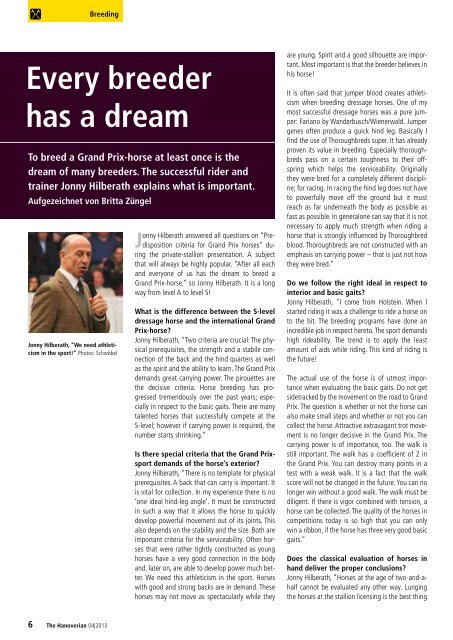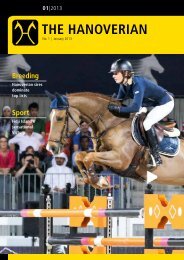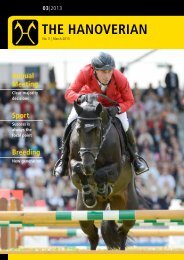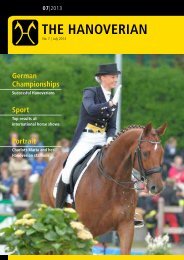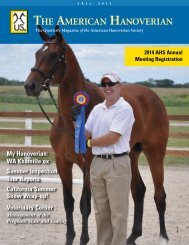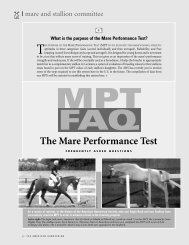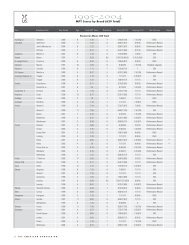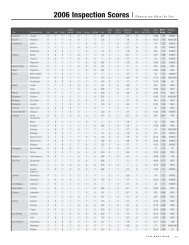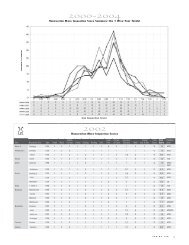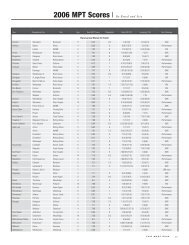THE HANOVERIAN
THE HANOVERIAN
THE HANOVERIAN
You also want an ePaper? Increase the reach of your titles
YUMPU automatically turns print PDFs into web optimized ePapers that Google loves.
Breeding<br />
Every breeder<br />
has a dream<br />
To breed a Grand Prix-horse at least once is the<br />
dream of many breeders. The successful rider and<br />
trainer Jonny Hilberath explains what is important.<br />
Aufgezeichnet von Britta Züngel<br />
Jonny Hilberath, “We need athleticism<br />
in the sport!” Photos: Schwöbel<br />
Jonny Hilberath answered all questions on “Predisposition<br />
criteria for Grand Prix horses” during<br />
the private-stallion presentation. A subject<br />
that will always be highly popular. “After all each<br />
and everyone of us has the dream to breed a<br />
Grand Prix-horse,” so Jonny Hilberath. It is a long<br />
way from level A to level S!<br />
What is the difference between the S-level<br />
dressage horse and the international Grand<br />
Prix-horse?<br />
Jonny Hilberath, “Two criteria are crucial: The physical<br />
prerequisites, the strength and a stabile connection<br />
of the back and the hind quarters as well<br />
as the spirit and the ability to learn. The Grand Prix<br />
demands great carrying power. The pirouettes are<br />
the decisive criteria. Horse breeding has progressed<br />
tremendously over the past years; especially<br />
in respect to the basic gaits. There are many<br />
talented horses that successfully compete at the<br />
S-level; however if carrying power is required, the<br />
number starts shrinking.”<br />
Is there special criteria that the Grand Prixsport<br />
demands of the horse’s exterior?<br />
Jonny Hilberath, “There is no template for physical<br />
prerequisites. A back that can carry is important. It<br />
is vital for collection. In my experience there is no<br />
‘one ideal hind-leg angle’. It must be constructed<br />
in such a way that it allows the horse to quickly<br />
develop powerful movement out of its joints. This<br />
also depends on the stability and the size. Both are<br />
important criteria for the serviceability. Often horses<br />
that were rather tightly constructed as young<br />
horses have a very good connection in the body<br />
and, later on, are able to develop power much better.<br />
We need this athleticism in the sport. Horses<br />
with good and strong backs are in demand. These<br />
horses may not move as spectacularly while they<br />
are young. Spirit and a good silhouette are important.<br />
Most important is that the breeder believes in<br />
his horse!<br />
It is often said that jumper blood creates athleticism<br />
when breeding dressage horses. One of my<br />
most successful dressage horses was a pure jumper:<br />
Fariano by Wanderbusch/Wienerwald. Jumper<br />
genes often produce a quick hind leg. Basically I<br />
find the use of Thoroughbreds super. It has already<br />
proven its value in breeding. Especially thoroughbreds<br />
pass on a certain toughness to their offspring<br />
which helps the serviceability. Originally<br />
they were bred for a completely different discipline;<br />
for racing. In racing the hind leg does not have<br />
to powerfully move off the ground but it must<br />
reach as far underneath the body as possible as<br />
fast as possible. In generalone can say that it is not<br />
necessary to apply much strength when riding a<br />
horse that is strongly influenced by Thoroughbred<br />
blood. Thoroughbreds are not constructed with an<br />
emphasis on carrying power – that is just not how<br />
they were bred.”<br />
Do we follow the right ideal in respect to<br />
interior and basic gaits?<br />
Jonny Hilberath, “I come from Holstein. When I<br />
started riding it was a challenge to ride a horse on<br />
to the bit. The breeding programs have done an<br />
incredible job in respect hereto. The sport demands<br />
high rideability. The trend is to apply the least<br />
amount of aids while riding. This kind of riding is<br />
the future!<br />
The actual use of the horse is of utmost importance<br />
when evaluating the basic gaits. Do not get<br />
sidetracked by the movement on the road to Grand<br />
Prix. The question is whether or not the horse can<br />
also make small steps and whether or not you can<br />
collect the horse. Attractive extravagant trot movement<br />
is no longer decisive in the Grand Prix. The<br />
carrying power is of importance, too. The walk is<br />
still important. The walk has a coefficient of 2 in<br />
the Grand Prix. You can destroy many points in a<br />
test with a weak walk. It is a fact that the walk<br />
score will not be changed in the future. You can no<br />
longer win without a good walk. The walk must be<br />
diligent. If there is vigor combined with tension, a<br />
horse can be collected. The quality of the horses in<br />
competitions today is so high that you can only<br />
win a ribbon, if the horse has three very good basic<br />
gaits.”<br />
Does the classical evaluation of horses in<br />
hand deliver the proper conclusions?<br />
Jonny Hilberath, “Horses at the age of two-and-ahalf<br />
cannot be evaluated any other way. Lunging<br />
the horses at the stallion licensing is the best thing<br />
6 The Hanoverian 04|2013


